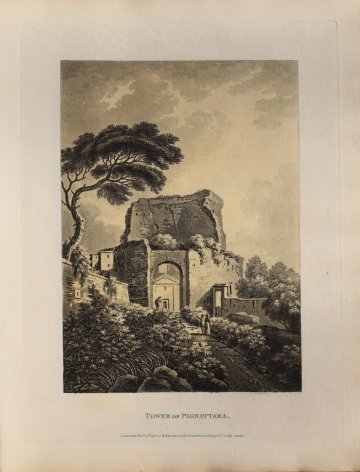James Merigot. (Tower of Pignattarra). Ruines de Rome. London 1796-98. $195.00

Tower of Pignattarra
James Merigot (1760–1824) was a French engraver and publisher who is known for an attractive album of 62 aquatinted plates designed and engraved by Marigot himself. Titled A Select Collection of Views and Ruins in Rome and its Vicinity. Recently executed from Drawings made upon the spot. The plates are dated 1796-1798 and are printed on watermarked laid paper with descriptive text in English and French. Many similar books were produced during the late 18th and early 19th centuries due to the rise of Neo-classicism among the British populace. This work was unique in its particular attention to the accurate depiction of the Roman ruins. Merigot visited each of the ruins and drew them in person, making this historically significant as an important record both of Ancient Rome and the state of Roman ruins at the turn of the 19th century. It also is a reminder of how the city would have looked at the height of the Romantic era when Rome embodied many Romantic ideals, not least the traces of a vanished civilization.
"Two miles from the Porta Maggiore, on the via Labricana, we find the remains of the mausoleum of Helena the mother of Constantine the Great. This monument now called the Tower Pignattarra, was built by Constantine for the repository of his mother's ashes, which were contained in a large urn of porphyry now to be seen in the Musuem of the Vatican. This structure, having been destroyed during the incursions of the barbarians, Urban VIII caused the ruins to be cleared and to preserve the memory of the place, ordered a chapel to be erected on it, and consigned it to the protection of the chapter of St John de Lateran."
Uncolored sepia toned aquatint engraving.
9.5 x 12 inches sheet size.
Excellent condition.
or click to inquire about this print.
